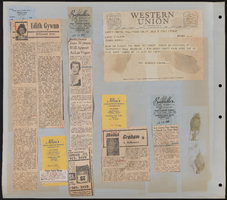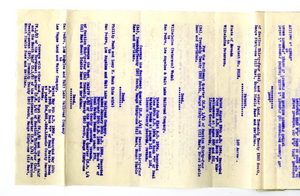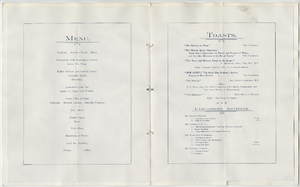Search the Special Collections and Archives Portal
Search Results
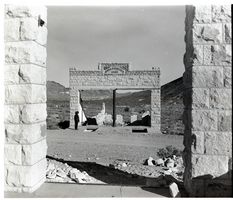
Film transparency of the ruins of the H. D. and L. D. Porter Brothers Store, Rhyolite, Nevada, November 25, 1948
Date
1948-11-25
Archival Collection
Description
An unidentified person looks at the ruins of the H. D. and L. D. Porter Brothers Store in Rhyolite, Nevada. The remains of two wooden buildings and several mining tailing piles are visible in the background. Originally from Illinois, the brothers opened their first store in Johannesburg, Ca. in 1902. Moving with the mining booms, they opened stores in Ballarat, Beatty, Pioneer and Rhyolite. From the Ballarat store, H. D. Porter loaded thirty tons of merchandise onto an 18-mule team freight wagon and came east across Death Valley to the Bullfrog District. The original store was built on Main St. After the move to Golden St., the wooden building was used as a furniture store for the Porter Brothers. With the purchase of a lot on Golden Ave. the construction of a new stone building began in July 1906 and was finished four months later. According to the Rhyolite Herald, November 1906 "This is a large substantial structure, practically fireproof, and occupies a prominent site on Golden Street. The main floor is 30 x 80 feet, with a basement and gallery." Nels Linn was the contractor who did the stonework. The estimated cost was $10,000 for the complete construction of the building. One of the signs that hung from the Porter Brothers Store was "All Things Good But Whiskey". With all the saloons already established in Rhyolite, the Porter Brothers maintained a reputation of never selling liquor. Rhyolite is a ghost town in Nye County, Nevada. It is in the Bullfrog Hills, about 120 miles (190 km) northwest of Las Vegas, near the eastern edge of Death Valley. The town began in early 1905 as one of several mining camps that sprang up after a prospecting discovery in the surrounding hills. During an ensuing gold rush, thousands of gold-seekers, developers, miners and service providers flocked to the Bullfrog Mining District. Many settled in Rhyolite, which lay in a sheltered desert basin near the region's biggest producer, the Montgomery Shoshone Mine. Rhyolite declined almost as rapidly as it rose. After the richest ore was exhausted, production fell. The 1906 San Francisco earthquake and the financial panic of 1907 made it more difficult to raise development capital. In 1908, investors in the Montgomery Shoshone Mine, concerned that it was overvalued, ordered an independent study. When the study's findings proved unfavorable, the company's stock value crashed, further restricting funding. By the end of 1910, the mine was operating at a loss, and it closed in 1911. By this time, many out-of-work miners had moved elsewhere, and Rhyolite's population dropped well below 1,000. By 1920, it was close to zero. After 1920, Rhyolite and its ruins became a tourist attraction and a setting for motion pictures. Most of its buildings crumbled, were salvaged for building materials, or were moved to nearby Beatty or other towns, although the railway depot and a house made chiefly of empty bottles were repaired and preserved. The town is named for rhyolite, an igneous rock composed of light-colored silicates, usually buff to pink and occasionally light gray. It belongs to the same rock class, felsic, as granite but is much less common.
Image
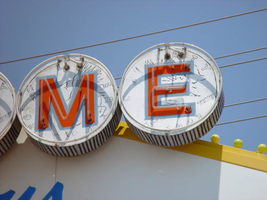
Photographs of Welcome to Fabulous Las Vegas sign, Las Vegas (Nev.), 2002
Date
2002
Archival Collection
Description
Daytime views of the Welcome to Fabulous Las Vegas sign on the Strip. Information about the sign is available in the Southern Nevada Neon Survey Data Sheet.
Site name: Welcome to Las Vegas neon sign
Site address: 5200 S Las Vegas Blvd
Sign owner: YESCO
Sign details: The sign sits as a welcome to travelers entering the Las Vegas experience via Las Vegas Blvd The sign itself resides in the middle of traffic median directly in the middle of the road.
Sign condition: Structure 5 Surface 5 Lighting 5
Sign form: Pylon
Sign-specific description: The sign itself is a classic roadside pole design which faces North/South. It is double backed, internally lit with a border of yellow incandescent bulbs along the flat edge of its width. Across the top of the sign seven white neon circles house separate red neon letters which form the word welcome. Crowning the sign at the very peak, above the word welcome, is a seven pointed neon star comprised of orange and yellow neon. The cabinet itself is faced with translucent white plastic and treated with blue and red painted text. The South side of the sign reads with the Neon welcome word then in blue painted text "To Fabulous" in a 50's style text reminiscent of that used in the Last Frontier property, and cursive. The Words "Las Vegas" are spelled in all caps, in red block text. And below that in smaller blue text the word "Nevada" are spelled in all caps block text.
Sign - type of display: Neon; Incandescent; Backlit
Sign - media: Steel; Plastic
Sign - non-neon treatments: Graphics; Paint
Sign animation: chasing, flashing
Sign environment: The famous Welcome to Las Vegas sign sits alone at the South end of the strip and is often the very first sign a traveler encounters when entering the strip. It casts a surprisingly powerful glow over the barren median which it stands. It stands as a gateway to the extravaganza that is Las Vegas. When leaving the main drag headed south the sign has an equal effect of being a lone gateway in and out of the Strip.
Sign manufacturer: YESCO
Sign designer: Betty Willis
Sign - date of installation: 1959
Sign - thematic influences: Although it has no specific theme, it is from a specific period in Las Vegas History. It is the quintessential roadside pylon design. With an exposed steel center pole double backed marquee it is reminiscent of the common design of the roadside motor inn.
Sign - artistic significance: This sign has become perhaps the most copied icon of Las Vegas, as it was never copyrighted. It is a ubiquitous symbol of the city.
Surveyor: Joshua Cannaday
Survey - date completed: 2002
Sign keywords: Chasing; Flashing; Pylon; Neon; Incandescent; Backlit; Steel; Plastic; Paint; Graphics
Site name: Welcome to Las Vegas neon sign
Site address: 5200 S Las Vegas Blvd
Sign owner: YESCO
Sign details: The sign sits as a welcome to travelers entering the Las Vegas experience via Las Vegas Blvd The sign itself resides in the middle of traffic median directly in the middle of the road.
Sign condition: Structure 5 Surface 5 Lighting 5
Sign form: Pylon
Sign-specific description: The sign itself is a classic roadside pole design which faces North/South. It is double backed, internally lit with a border of yellow incandescent bulbs along the flat edge of its width. Across the top of the sign seven white neon circles house separate red neon letters which form the word welcome. Crowning the sign at the very peak, above the word welcome, is a seven pointed neon star comprised of orange and yellow neon. The cabinet itself is faced with translucent white plastic and treated with blue and red painted text. The South side of the sign reads with the Neon welcome word then in blue painted text "To Fabulous" in a 50's style text reminiscent of that used in the Last Frontier property, and cursive. The Words "Las Vegas" are spelled in all caps, in red block text. And below that in smaller blue text the word "Nevada" are spelled in all caps block text.
Sign - type of display: Neon; Incandescent; Backlit
Sign - media: Steel; Plastic
Sign - non-neon treatments: Graphics; Paint
Sign animation: chasing, flashing
Sign environment: The famous Welcome to Las Vegas sign sits alone at the South end of the strip and is often the very first sign a traveler encounters when entering the strip. It casts a surprisingly powerful glow over the barren median which it stands. It stands as a gateway to the extravaganza that is Las Vegas. When leaving the main drag headed south the sign has an equal effect of being a lone gateway in and out of the Strip.
Sign manufacturer: YESCO
Sign designer: Betty Willis
Sign - date of installation: 1959
Sign - thematic influences: Although it has no specific theme, it is from a specific period in Las Vegas History. It is the quintessential roadside pylon design. With an exposed steel center pole double backed marquee it is reminiscent of the common design of the roadside motor inn.
Sign - artistic significance: This sign has become perhaps the most copied icon of Las Vegas, as it was never copyrighted. It is a ubiquitous symbol of the city.
Surveyor: Joshua Cannaday
Survey - date completed: 2002
Sign keywords: Chasing; Flashing; Pylon; Neon; Incandescent; Backlit; Steel; Plastic; Paint; Graphics
Mixed Content
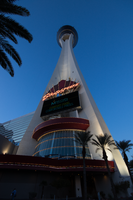
Photographs of Stratosphere signs, Las Vegas (Nev.), March 6, 2017
Date
2017-03-06
2017-07-12
Archival Collection
Description
The Stratosphere Casino, Hotel and Tower sits north of the Las Vegas Strip at 2000 South Las Vegas Boulevard. Information about the sign is available in the Southern Nevada Neon Survey Data Sheet.
Site address: 2000 S Las Vegas Blvd
Sign owner: American Casino and Entertainment Properties
Sign details: This location was the site of Bob Stupak's Vegas World that opened in 1979. The Stratosphere opening in this location in 1996, the Stratosphere includes the tallest freestanding observation tower in the United States. Developed by Bob Stupak, the Stratosphere was meant to be a landmark for the city of Las Vegas. As the years progressed, plans for restaurants and thrill rides came to fruition and the hotel now boasts several popular attractions. From 1996 to 2010, the Stratosphere went through bankruptcy, remodeling, renovations, additions, and new ownership. The current owner, American Casino and Entertainment Properties, also owns three other properties in the Las Vegas area.
Sign condition: About 4-5, appears to have relatively low damage, if any
Sign form: Porte cochere near main entrance
Sign-specific description: Stratopshere in orange neon, three vertical, squiggly lines (red, blue) pointing up toward triangular shape; second neon sign on right side of front facade, "Stratopshere" in orange, overlaid on top of blue cloud shape and orange, poles
Sign - type of display: Neon and plastic back lit sign
Sign - media: Steel and Electronic Media Screen
Sign - non-neon treatments: Electronic Media Screen and plastic back lit sign
Sign animation: Flashing for the design behind their logo on their sign
Sign environment: Located on the North end of the strip on Sahara, just across the street from the SLS Casino.
Sign architect of record: Skidmore, Owings, and Merrill
Sign - date of installation: Circa 1996 around opening
Sign - date of redesign/move: Around 2014/15 the background colors of the sign switched from a blue sky color to a pink/purple design.
Sign - thematic influences: Design similar to radio transmission towers; Stupak compared his design to Eiffel Tower and Space Needle (Seattle).
Survey - research locations: Stratosphere website http://www.stratospherehotel.com/?&mkwid=s0JHs4Hf3_dc&pcrid=102775265532&pkw=stratosphere%20las%20vegas&pmt=p&gclid=CjwKCAjwhOvPBRBxEiwAx2nhLp_Mtg7n6c-FUkbwYgY8MD3TJzgUWEp4WX1IgzePUlk1y-Rat_wmexoCJs8QAvD_BwE, recorder's office, Assessor's page
Survey - research notes: The top of the Stratosphere has blinking lights, but it is not confirmed if they are LED or Neon.
Surveyor: Carlyle Constantino
Survey - date completed: 2017-07-12
Sign keywords: Porte-cochère; Neon; Plastic; Steel; Flashing; Video screen; Incandescent
Site address: 2000 S Las Vegas Blvd
Sign owner: American Casino and Entertainment Properties
Sign details: This location was the site of Bob Stupak's Vegas World that opened in 1979. The Stratosphere opening in this location in 1996, the Stratosphere includes the tallest freestanding observation tower in the United States. Developed by Bob Stupak, the Stratosphere was meant to be a landmark for the city of Las Vegas. As the years progressed, plans for restaurants and thrill rides came to fruition and the hotel now boasts several popular attractions. From 1996 to 2010, the Stratosphere went through bankruptcy, remodeling, renovations, additions, and new ownership. The current owner, American Casino and Entertainment Properties, also owns three other properties in the Las Vegas area.
Sign condition: About 4-5, appears to have relatively low damage, if any
Sign form: Porte cochere near main entrance
Sign-specific description: Stratopshere in orange neon, three vertical, squiggly lines (red, blue) pointing up toward triangular shape; second neon sign on right side of front facade, "Stratopshere" in orange, overlaid on top of blue cloud shape and orange, poles
Sign - type of display: Neon and plastic back lit sign
Sign - media: Steel and Electronic Media Screen
Sign - non-neon treatments: Electronic Media Screen and plastic back lit sign
Sign animation: Flashing for the design behind their logo on their sign
Sign environment: Located on the North end of the strip on Sahara, just across the street from the SLS Casino.
Sign architect of record: Skidmore, Owings, and Merrill
Sign - date of installation: Circa 1996 around opening
Sign - date of redesign/move: Around 2014/15 the background colors of the sign switched from a blue sky color to a pink/purple design.
Sign - thematic influences: Design similar to radio transmission towers; Stupak compared his design to Eiffel Tower and Space Needle (Seattle).
Survey - research locations: Stratosphere website http://www.stratospherehotel.com/?&mkwid=s0JHs4Hf3_dc&pcrid=102775265532&pkw=stratosphere%20las%20vegas&pmt=p&gclid=CjwKCAjwhOvPBRBxEiwAx2nhLp_Mtg7n6c-FUkbwYgY8MD3TJzgUWEp4WX1IgzePUlk1y-Rat_wmexoCJs8QAvD_BwE, recorder's office, Assessor's page
Survey - research notes: The top of the Stratosphere has blinking lights, but it is not confirmed if they are LED or Neon.
Surveyor: Carlyle Constantino
Survey - date completed: 2017-07-12
Sign keywords: Porte-cochère; Neon; Plastic; Steel; Flashing; Video screen; Incandescent
Mixed Content

Letter from C. A. Earle Rinker to his sisters, undated (ca. 1907)
Date
1907
Archival Collection
Description
Letter from C. A. Earle Rinker to his sisters, undated (ca. 1907)
Text
Molasky, Irwin
Irwin Molasky (1927-2020) is a Las Vegas, Nevada real estate developer and chairman of the Molasky Group of Companies. He was involved in many major Las Vegas development projects including Paradise Palms, Sunrise Hospital, Nathan Adelson Hospice, the University of Nevada, Las Vegas (UNLV), the Boulevard Mall, Bank of America Plaza, Regency Towers, and Park Towers.
Person
Pagination
Refine my results
Content Type
Creator or Contributor
Subject
Archival Collection
Digital Project
Resource Type
Year
Material Type
Place
Language
Records Classification



